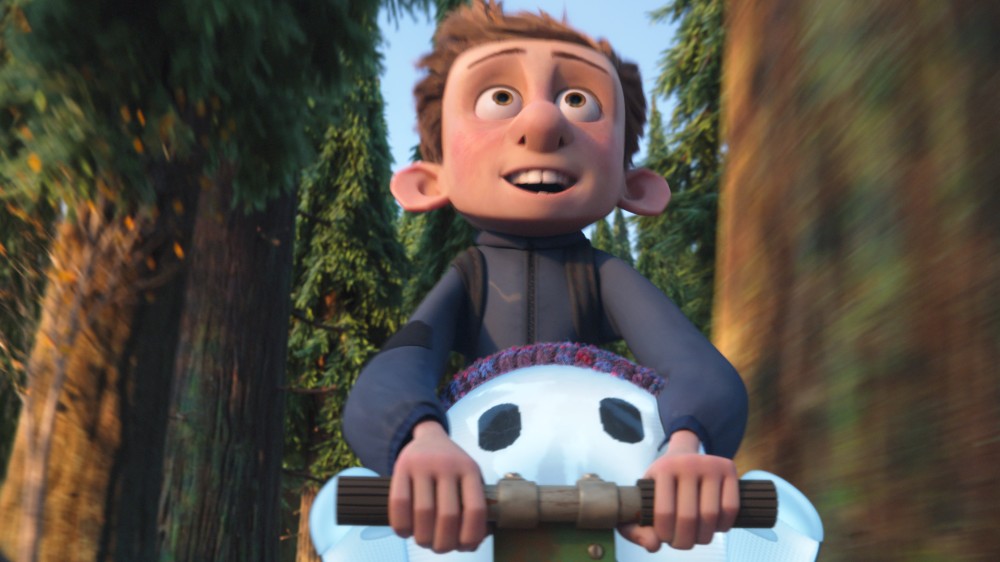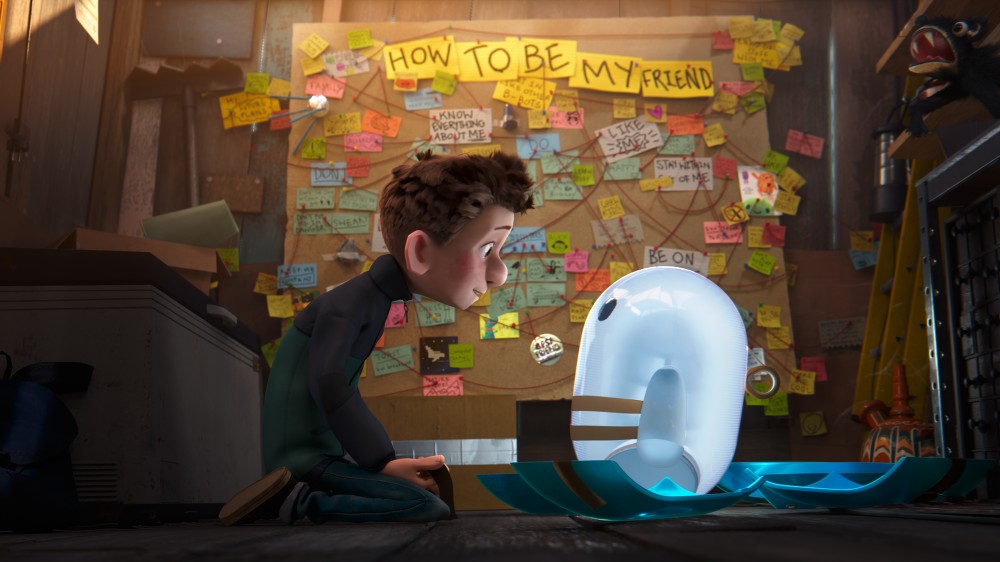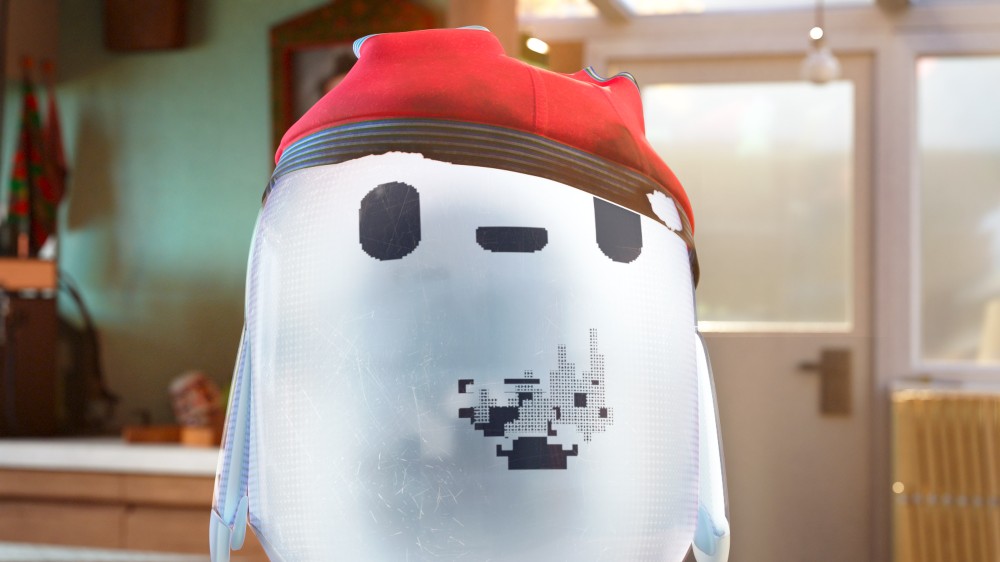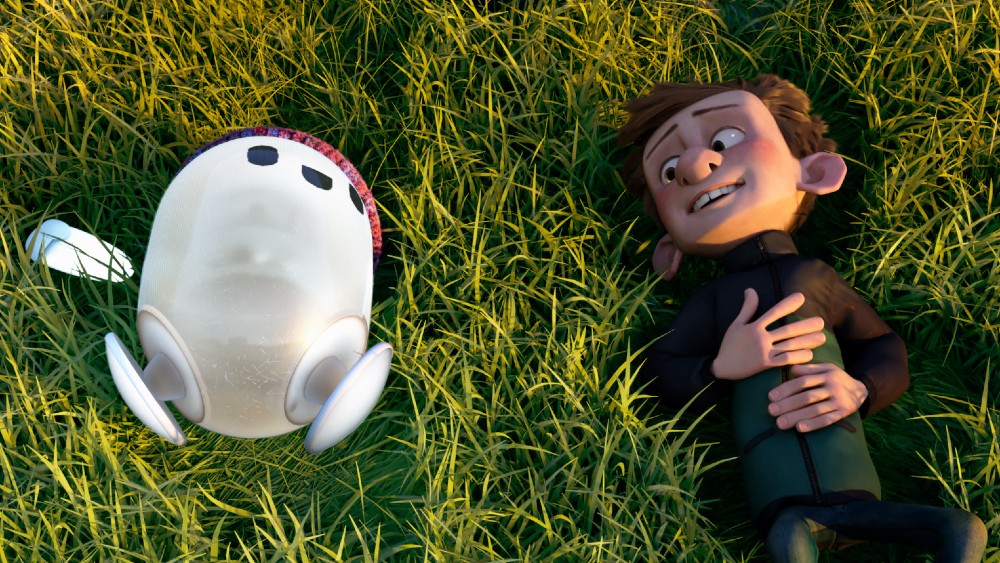
If you were to see 20th Century Studios’ new animated film, Ron’s Gone Wrong, you’re not likely to realize that it was written and directed by two Brits with Sarah Smith and her co-writer, Peter Baynham coming over from Aardman Studios’ holiday animated film Arthur Christmas, released by Sony Pictures about ten years ago.
Ron’s Gone Wrong is the first animated feature from London’s Locksmith Studios, which Smith founded, but it’s very much a movie set in the States as it follows a middle schooler named Barney (voiced by Jack Dylan Grazer from It), a lonely introvert who feels left out when everyone at his school gets a B-Bot robot friend, except for him. After his birthday, his father (Ed Helms) surprises Barney with a semi-malfunctional B-Bot that Barney names Ron (voiced by Zack Galifianakis). When he brings Ron to school, Barney becomes even a bigger laughing stock, until Ron shows that being disconnected from the network actually allows him to do things other B-Bots can’t.
At its heart, Ron’s Gone Wrong might be considered a kids’ film with all the colors and craziness kids expect, but it’s also something that parents will probably relate to in some ways. Smith herself is a pretty amazing woman to talk to, being one of few female animation directors, but also someone who created a company mainly to give her home country a base for doing bigger-scale animation.
Below the Line got on the phone with Ms. Smith earlier this week to talk about making Ron’s Gone Wrong and also about the general state of animation in the UK.

Below the Line: I know you had a background writing, directing and producing British comedy for some time, so how did you end up shifting to animation when you did Arthur Christmas? And after shifting to animation, you kind of stayed there, so how did that happen?
Sarah Smith: Yeah, when you go to animation, you do stay there sometimes. I started in lots of edgy, adult comedy, first in radio and then in television, and along the way, one of the people I met right at the beginning of my career was Pete Baynham, who writes for people like Sacha Baron Cohen, and so on. This was kind of way back in the day, and we did lots of different things together. The first thing that we wrote together was an adult animated TV series called I Am Not an Animal that had Simon Pegg and Steve Coogan, and people like that in it. It was hugely good fun, and it was the first time we’d ever worked together as sort of co-writers. Shortly after, I got offered a job by Aardman, because I’d been in touch with them some years before about something they were doing, and they approached me and asked me if I would come and head up their feature department. Because they’re kind of national treasures in the UK, I thought that’s a fun job to do. I went into Aardman and brought Pete and bought an idea off him, and then we wrote Arthur Christmas. I just kind of got stuck, partly because I had a kid at that time, and animated movies are the first kind of meaty culture that you share with your child. I kind of fell in love with it, because as well as doing all the sort of comedy that I’d always done before, you can also wear your heart on your sleeve and tell big emotional stories. I guess me and Pete are both big softies, so we really enjoy that.
BTL: You’re one of the founders of Locksmith Animation, and this is the first movie done by Locksmith, so how did that come together as a company?
Smith: After I made Arthur Christmas, I came back to the UK with my child, who was then like 2 [laughs], and I love the creative community in London. There are so many great funny creators and writers and so on, and we also have an amazing visual effects industry. I felt like it was a kind of weird thing that we had never had the equivalent of a DreamWorks or Pixar or so in the UK. Aardman are quite specialist in that mostly they’re doing stop-frame [animation], but to do those mainstream CG movies, it felt like we had everything that you would need to do it. I literally downloaded “How to Write a Business Plan” off the internet [laughs], and I put together a proposal for a British studio and went out trying to raise finance. I brought in Julie [Lockhart], who I met at Aardman, she was the “lock” of Locksmith, and then eventually we met Liz Murdoch, and she backed the company. I’ve spent the last seven years building that and making my first movie. I’ve now stepped away from the company to kind of take a moment and relaunch again. It’s been a huge venture, and I’m super-pleased with the fact that now on the back of Locksmith starting, there’s more and more feature animation in London. It’s now possible in the future for people to make those movies in the UK, which I’m sure I will do again in the future, but I’m gonna have a bit of a moment. [laughs]
BTL: I don’t know how old your child is, but I assume the premise for Ron’s Gone Wrong came out of how kids literally live on electronics now from a certain age, either on an iPad or phone or something. It seems so prevalent these days.
Smith: 100%. I mean, I’m very passionate about making stuff in the feature animation space, making stuff for kids and families, but it’s relev ant to their actual lives rather than just being kind of popcorn entertainment that actually speaks to them in the way that maybe speak to me. I was watching the Spike Jonze movie Her on a screener, and I thought, “I need to make this movie for my three-year-old,” as she was then. She was constantly absorbed in the iPad and saying to me, “Mommy, we need to buy Spring Bounce fabric conditioner, because it makes your clothes so soft.” She literally believed that everything that was being said to her from that space was real and true. As a parent, you’re terrified. You’re aware how difficult it can be for kids to navigate this space. Friendship is a difficult enough thing for kids to navigate without all of the pressures of that online world, and I felt like it was the most relevant thing happening in families all around me, and we needed to make that movie.
ant to their actual lives rather than just being kind of popcorn entertainment that actually speaks to them in the way that maybe speak to me. I was watching the Spike Jonze movie Her on a screener, and I thought, “I need to make this movie for my three-year-old,” as she was then. She was constantly absorbed in the iPad and saying to me, “Mommy, we need to buy Spring Bounce fabric conditioner, because it makes your clothes so soft.” She literally believed that everything that was being said to her from that space was real and true. As a parent, you’re terrified. You’re aware how difficult it can be for kids to navigate this space. Friendship is a difficult enough thing for kids to navigate without all of the pressures of that online world, and I felt like it was the most relevant thing happening in families all around me, and we needed to make that movie.
BTL: Was this something you were developing with Peter, at least the script, a while ago?
Smith: Pete and I’ve worked together in different combinations for years and years, and then we started writing together for television, and then we wrote Arthur, and then we wrote this. The joy of it is that Pete is my best friend. We’ve known each other for 30 years. We both have children at the same time, quite late in life. We just have an enormous shared experience of people that we’ve known, of each other’s lives and families and friends. That is the basis of the characters that we create together — it’s a joyful thing writing with someone else. The empty page is just the most daunting, exhausting thing you can get, but Peter is brilliant. He just spouts so much stuff that we talk and talk and talk, and then he will just cover that page in a sort of fairly chaotic, but wonderful way. And then he takes the first pass and I get the last word. That’s how we work together.
BTL: How did you come up with Barney as your protagonist and also get Jack Dylan Grazer to voice him? I thought he did a great job bringing that character to life with his voice.
Smith: I think Jack is an absolute, massive rising star. I really do. We met him when he was about 12, I think, and he was brought in as somebody who could potentially just do some scratch for us, because early on when you’re putting your animatic reel together, you often just have temporary scratch voices. Rather than it being middle-aged British people voicing an American boy, they introduced us to Jack and said, “He’d be great,” and he was so great, we kept him all the way through. And he just turned into this star in front of our eyes. Suddenly, there he was in Shazam! and It. He’s done so many amazing bits of work, and he is an extraordinary kid. He can turn out a performance that makes you cry, and then he just picks his phone up and carries on playing on his phone, and then gives you another take that makes you cry. He’s an absolute professional, super-charming, and so versatile. I think he’s going to be a megastar. We were lucky to meet him.
BTL: Was Zack Gallifinakis another early person involved?
Smith: Noooo, nooooo! That was actually quite hard to figure out. When Pete and I were writing, we thought about [Ron’s] voice, and we always talked about the Microsoft paperclip that used to say, “Hi, it looks like you’re writing a letter. Can I help you?” that sort of perky, helpful customer service voice that you get. It needed to be very sort of generic in a way, but then you also wanted some character adding to it. It was quite a tricky thing, because at one point, we see Ron under Barney’s bed. Well, you don’t want to feel like there’s a man under his bed. It had to be a voice that was upbeat, that was kind of light enough but felt neutral, but was also it was able to carry all sorts of nuance and cheekiness and as soon as we started to hear Zack against it, we could tell that was the right direction.
BTL: When I saw the trailer, I thought it was Patton Oswalt at first, because he obviously’s done a ton of animation, and I mean, he’s great, but he is in quite a lot of stuff, too, so I’m glad you got someone else.
Smith: Yes, he’s doing well, Patton. He’s good for work I reckon. But also Ron needs to be a little bit dangerous and out of control, and Zack gives you that edge completely.
BTL: You mentioned animatic work before, and I’ve had a chance to speak to directors and animators at DreamWorks and Pixar and Blue Sky about their technique, and it’s different everywhere. Some do all the voices first. Some do animated storyboards. Some places have animators working on a scene from beginning to end, others split up the work by different characters. What is your way of working and how you handle it?
Smith: In the past, when I did Arthur, I actually did a radio play of the whole thing, and I had not the final actors, but really good actors playing it, and I took them into a radio studio with all the sound effects, and we spent three days recording the movie like a radio play. I gave that to the board artists and they used that as inspiration, and that was a brilliant process for us. This was different. We did this more the traditional way where different people in the studio took different characters. I played Donka before Olivia Colman. [laughs] I have to admit that she’s a mite bit better than me, but I did that character. JP [Co-director Jean-Philippe Vine] did Graham, the Dad. We found the solution for each character and somebody that could do a version of it. Obviously, the upside of that is that as you’re putting up the reels, if you’re then developing and tweaking the script, it’s easy to do that because you’re using your own voices to keep trying stuff out until you nail it down. And then the voice recordings came in about a year in probably. We actually had the cast coming in and that changes things again, of course, and with all the performances, it gives the animators something to work with. In animation, it tends to naturally fall out that you find some individual animator is the hero guardian of a character — you love what they do with the character and you get everyone else to look at that, and they kind of become an unofficial character muse. We were always looking to play to everybody’s strengths, basically as you go.
BTL: It seems that these days, you can’t really make a big CG animated movie without a co-director, because it’s just too big a job for one person. Did you find your co-directors fairly early in the process?
Smith: I think it depends on the scale of the production. Definitely on this movie, because we then went into lockdown and all the crew went home, and this is a brand, new pipeline. This is Double Negative, who’d never done an animated feature before, so you’re already in that situation of having to lay the track, as well as parcel it on the train. It was already a big challenge when you’re doing something for the first time in a new pipe, and then suddenly, everybody was behind in their kitchen, and the amount of labor involved in communicating and directing everybody one by one, it just went up exponentially. JP and I were just on different Zoom calls all day, talking to each other, and going from one animator to edit to layout, from one thing after another, and it was incredibly full on. I don’t think it would be possible for one person to do it all.
BTL: How did you go about finding your Head of Story and some of the other key roles? Were you able to poach some of the people you worked with at Aardman for Arthur Christmas?
Smith: It’s a mixture. Definitely, some of my favorite people from Arthur came back, the people who did the most amazing work who I kept in touch with, so we have people from story and other departments as well from Arthur, which was great. But we also collected new talent from within the UK. I spent so much of my time at Locksmith basically stalking people. You hear that some studio or other is going through a rocky patch, and I would literally just come and plant myself in a cafe nearby in LA and invite people to come and talk to me. I just kind of targeted people whose work I love and tried to inspire them with the movie, really, and with what we were trying to do. It’s a big ask, because mostly, you’re asking them to move their whole life, uproot from Los Angeles and move their families and their children and come to the UK for one, two or three years. It’s a bit thing to get people to do, so I put a huge amount of work into recruiting. I always set my sights on the best people. It was never who would come in, it was who would be brilliant. The joy of that is that when the team do come together, they hung on with a complete commitment to the project, so there’s a great belief and atmosphere in the crew that comes with that.
BTL: Animation and VFX are really booming industries right now, and I feel like a lot of younger people are really interested in going that route, plus they all use computers and phones and other technology to do their own animation. Have you found that as well?
Smith: It is a booming industry and that can be challenging because there’s competition for the talent. What I also think happens in London, around the Harry Potter movies, the capacity just increased so much, and the London visual effects industry grew exponentially and managed to find and train more and more talent. And now, really, London’s probably the center of the world for visual effects. I see it happening in feature animation as well, on the back of us forming Locksmith, Double Negative forms DNEG Animation in order to make the movie for us, and now they have other clients from other parts of the world. So they’re making other movies and there are other studios in London getting to do it. I think it’s actually much easier when there’s an industry with multiple players, when there are like four or five companies working in that space. It’s easier to attract the talent to come and be based in your city. They move around from job to job between that. It’s actually almost harder when you’re the only game in town and you’re trying to move countries, just for you. Also, I guess it gives people the aspiration and the training and the opportunity to learn those tasks. So hopefully, the UK will become a really great center for CG animation as it has the visual effects and the tax credits, and so on in our favor, so I hope that will happen.
It’s also true, as you say, that young kids are able to do this. My 12-year-old showed me her first bit of animation on her iPad that she just taught herself. I think what will happen, too, as time goes on, is that you’ll have smaller crowds and people who are more generalists. They’re more filmmakers. They’re not specializing in one tool or another, but tools come easy to them. There are people that can use all different tools to help the filmmaking process, and I think that’s where the future will lie.
BTL: I love hearing that your daughter’s doing it, because as you well know, animation is still a heavily male-dominated field. I always wonder why there aren’t more girls doing it even though arts and technology have never been gender-specific.
Smith: Absolutely, I personally think that there are far more women. And visual effects is also very male-dominated. I know that from being in the lift at DNEG. There are quite a lot of women in production roles, but actually as artists less so. But I did notice that on this movie, we had a considerably higher proportion of female animators than we did 10 years ago on Arthur Christmas. I think the number of women coming into the industry is increasing and will continue to be so.
BTL: That’s great. I also want to ask about getting Henry Jackman for the score, because he’s done some amazing things, but there are lots of great composers out there. How did you end up working with him?
Smith: Partly, Henry often uses digital sounds in his music, which felt quite particularly appropriate for Ron, but also he just writes beautiful, emotional music. And is often the way, as we were putting the reels together, so many of the temp cues that we used just as scratch cues were from Henry’s scores. You kind of know that’s the right composer because his music fitted so beautifully. He just does beautiful simple stuff, he does stirring things. He also does my kind of funky electronic and digital sounds. He has such a great range as a composer, and as soon as I met him, it turns out he grew up 10 minutes up the road from where my house is in the countryside in Norfolk. He’s a massive British comedy fan, so he loves Alan Partridge, that Pete used to write. I just felt like he understood everything that we were trying to do in the movie, and he did absolutely beautiful work. He’s hugely great fun to work with as well. I had a blast with him.
BTL: I have to ask. Did you give him a first cut with his old music on it as temp?
Smith: Oh, yeah, and I just spoke to him last night. He said, “It’s your worst nightmare as a composer” when I sent him the main sequence of the movie, the big emotional climax, and we had used this fantastic piece of music he wrote for Kick-Ass. It’s just this beautiful building emotional thing. And I was like, “Henry, you can’t beat that. What are you going to do?” And he said, “Nope, nope, leave it with me.” And of course, sure enough, he came up with a piece that was even better for our movie, so… It’s quite hard when you’re asked to beat yourself, I think.
BTL: I speak to quite a few composers, and that seems to be an ongoing thing where filmmakers use their earlier music as temp and feel it’s perfect, but they can hear things or realize that the music is not right for whatever reason.
Smith: It’s maybe almost worse when they can see that it is right, and then they’re like, “Well, now what am I going to do, because actually, that piece that I wrote kind of really works there, but I’ve got to come up with something else.”
Ron’s Gone Wrong is now playing in theaters nationwide. All photos courtesy 20th Century Studios.







